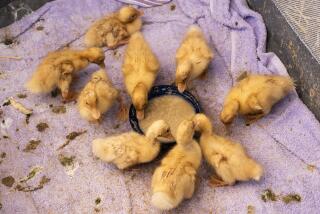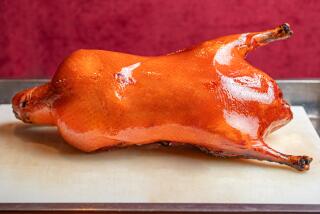Hunters Flock to Arkansas’ Stuttgart
- Share via
STUTTGART, Ark. — Ducks come down like broken kites, fluttering clumsily toward the glassy water.
The wounded quiver, and a dog leaps from a floating platform to retrieve them. Camouflaged hunters wade into knee-deep water for a closer look. A burly guide plucks a stiff feather from the back of a twitching bird and pokes the pointed quill into its neck, killing it instantly.
The hunters return to their foliage-covered hiding place and wait. They swap stories while all eyes scan the overcast sky--looking for more birds.
In Stuttgart, the self-proclaimed duck capital of the world, you can sum up a dislike for someone by simply saying, “I wouldn’t share a duck stand with him.”
Located in the heart of Arkansas’ Grand Prairie and the Mississippi Flyway, Stuttgart attracts duck hunters from throughout the world.
At one time, the Grand Prairie was a vast landscape of native grasses “as tall as a man,” some say. Early settlers came to the area to graze livestock and sell hay to northern states.
“The settlers would get off of their covered wagons and step down and you couldn’t see their heads,” says Pat Peacock, director of the Stuttgart Agricultural Museum.
Stuttgart’s skyline is dominated by grain silos, giving the impression of skyscrapers from a distance. The surrounding land is flat and flooded, the tall grass now replaced by a checkerboard of backwaters, bayous and fields of soybeans and rice. Two of the world’s largest rice producers are based in Stuttgart.
The term “Duck Capital” refers both to its claim as the nation’s top duck-hunting area, and the money that hunting provides.
The town of about 10,000 is home to the Wings Over the Prairie Festival in November, which includes the annual World Championship Duck-Calling Contest. The first winner, back in 1936, used only his mouth to simulate the duck call and won a $7 hunting coat. The 2001 winner, using a $150 acrylic duck call, took home about $40,000 worth of prizes.
The festival also includes the annual Queen Mallard beauty pageant that began in 1957.
Peacock was the city’s first Queen Mallard and is the only woman to win the duck-calling contest. She took home the prize two years in a row--in 1955 and 1956.
“I wasn’t too popular with the guys,” Peacock said. “But I used the money to go on to college.”
Peacock, an avid duck hunter in a sport dominated by men, was featured in a Sports Illustrated article and subsequently went on the road as a spokeswoman for a leading brand of hunting boots.
Once, she recalls, “ducks fell from the sky” onto Main Street, brought down by nature, not bullets.
In November 1973, a group of ducks flying over Stuttgart hit a cold spot in the upper atmosphere, froze and dropped to earth, some breaking storefront windows, damaging roofs and denting cars.
“You can’t imagine the damage that can be done from the impact of a frozen-solid duck,” Peacock says.
During the two duck hunting seasons--Nov. 18-Dec. 20 and Dec. 26-Jan. 21--hunting-related activities pump more than $2 million a day into the state’s economy, $1 million into Stuttgart alone. Annually, duck-hunting related retail sales funnel $55 million into the state’s economy, including about $3 million in sales tax and $1 million in income taxes. The sport provides about 1,700 jobs.
George Young, known locally as Junior, can make as much as $2,500 a day plucking, skinning, cleaning and packing the duck kills of hunters. He sells certain feathers for fly-fishing lures and saves the necks and feet for local hog farmers to use as feed.
“I was a welder, but I had a lung taken out from cancer, so I’m doing this,” says Young, a dead duck dangling from one hand, a bloody hatchet in the other.
The story of Mack’s Prairie Wings sport shop epitomizes the local duck-hunting phenomenon.
As more duck hunters began arriving in Stuttgart in the 1930s, McCollum’s Hardware Store, located on Main Street, began stocking hunting supplies. In 1944, a separate small store was opened for only hunting supplies.
Within 30 years, the hunting supply business expanded to include a 3,200-square-foot store. Today, Mack’s is located in a 90,000-square-foot store dedicated solely to waterfowl hunting and has a mail order operation that sent out 1.7 million catalogs last year to customers throughout the world.
The store’s hours of operation, to accommodate hunters, are 4:30 a.m. to 6 p.m., seven days a week.
Bayou Meto, which snakes through central Arkansas, is the largest state-owned public shooting ground in the country, with about 34,000 acres of flooded timber.
Ducks fly south en masse to escape the northern winters and return to cooler locations to raise their young in the spring. They come down along four separate flyways, the largest being along the Mississippi River. Arkansas has 8 million acres of the 24 million-acre Mississippi River Alluvial Plain, better known as the Delta--more than any other state.
Arkansas drew 100,000 duck hunters last year, and historically it has attracted the likes of William Faulkner and Clark Gable, as well as several presidents, from Teddy Roosevelt to the first George Bush. Legend has it that before early settlers came to Arkansas, the Quapaw Indians would mount stuffed ducks on their heads, swim underwater to a floating duck, then grab its legs and pull it under.
Though Arkansas is second to Louisiana in the number of all types of ducks killed annually--1.5 million, compared with Louisiana’s 2.5 million--it is No. 1 for mallards, the prized green-headed variety.
Scott Drummond’s Pintail Peninsula hunting lodge caters to the corporate crowd.
At $600 a day, Pintail is a high-end hunt club--once dubbed the “Taj Mahal of duck hunting” by the Wall Street Journal.
“I wanted some magnificence,” Drummond says. His 14,000-square-foot log cabin lodge has elk antler chandeliers that hang from a vaulted ceiling. Plush couches and carved wooden furniture surround a huge stone fireplace in the gathering room, its walls mostly windows looking out onto the flooded prairie.
About 10 miles from Pintail is Carlton Crosby’s Wild Wings Hunting Club.
More like a home than a vacation lodge, it offers full-service hunting trips at half the cost of places like Pintail.
A former farmer, Crosby now devotes his 1,275 acres to hunting--ducks, deer and dove.
He says he used to gross about $250,000 a year growing soybeans and rice, but had to put most of it back into the business. Now, he says he is grossing about the same amount, with fewer expenses.
“Duck hunting around here is a tradition,” Crosby says. “And because I’ve got hunting in my blood, this is something I’ve always wanted to do.”
More to Read
Sign up for The Wild
We’ll help you find the best places to hike, bike and run, as well as the perfect silent spots for meditation and yoga.
You may occasionally receive promotional content from the Los Angeles Times.






